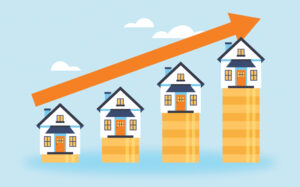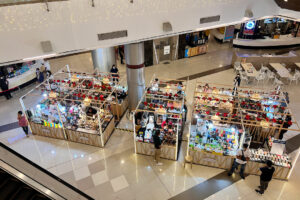Budding grounds for Philippine real estate’s growth

By Angela Kiara S. Brillantes, Special Features and Content Writer
Real estate is seen as one of the major drivers of the Philippine economy. Global data and business intelligence platform Statista bases this on the gross value added generated by the industry, which amounted to P536 billion from 2020 to 2022. Such share can be sustained, or even boosted, as big opportunities are seen for the industry this year.
As global management consulting firm McKinsey & Company shared on its website last March, “real estate is likely to experience continued recovery which is supported by emerging industries and easing restrictions.”
This development is set on a background where the Philippine economy grew by 4.3% in the second quarter (Q2) of 2023, continuously being one of the countries with the fastest gross domestic product growth rates in Southeast Asia.
According to diversified professional services and investment management company Colliers, in Q2 real estate is experiencing decelerating inflation, as well as the increase of development of office spaces (18.4%) and residential rentals, which are key factors for economic growth. With this, vacancy is expected to decline from 17.6% to 17% during the last quarter of the year, positively impacting residential rents and prices.
Similarly, Ayala Land, Inc. (ALI) sees the growth of the country’s real estate market to continue throughout this year. The developer sees that although the pace of growth may vary, the outlook remains positive given factors such as low interest rates, government infrastructure projects, and increased consumer confidence.
ALI also sees a variety of trends and opportunities in the current real estate investment environment.
“The rise of remote/online work and flexible office spaces has created a demand for residential developments that cater to work-from-home setups,” ALI shared in an email to BusinessWorld. “The growth of e-commerce has also led to increased demand for logistics and warehousing facilities. Additionally, sustainable and eco-friendly developments are gaining popularity among investors and consumers.”
Residential
Looking deeper into property segments, the residential segment is anticipated to remain buoyant, with the middle-income segment driving demand for affordable housing.
Such improvement can be seen in increased demand, as shown by figures from Colliers, which Global Property Guide cited in their recent analysis of the country’s residential real estate market. The data shows that 20,000 units were sold in 2022, a 54% increase from the previous year. In the first half of 2023, the high demand for outsourcing firms, consular offices, and multilateral lending firms from foreign investors has resulted in an increased use of offices, thus, positively impacting rents and prices.
Colliers added that rents climbed to 1%, with continued residential leasing in business districts. This was coupled with an increase in prices (3.3%), and a decrease in vacancy rate (16.9%). The vacancy rate, however, is more likely to increase in the following year due to new supply.
“Vacancy in the Metro Manila secondary market is stabilizing and this has been resulting in gradual improvement in rents and prices. Colliers still sees slower launches and completion this year, but we see the latter making a big comeback in 2024,” Joey Roi Bondoc, senior research manager at Colliers International Philippines, said in its most recent report for the residential segment.
“The upside for the sector is that developers have aggressively been scouting for developable parcels of land outside Metro Manila, targeting the end-user market,” he added. “Developers are undeniably banking on the government’s infrastructure push, aggressively and strategically acquiring land near the government’s big-ticket public projects. Moving forward, this should result in the development of more horizontal projects including resort-oriented master-planned communities.”
Furthermore, McKinsey sees residential buildings to likely drive growth in real estate and its recovery to pre-pandemic levels.
“Much of the sector is expected to recover to pre-pandemic levels by the end of 2023, and construction by the end of 2024. Much of this growth will likely be driven by residential building construction, predicted to grow by 12%. Non-residential construction, by contrast, has yet to recover to pre-pandemic levels,” it added.
Office
Within the office segment, McKinsey noted that the “return to office” trend caused a high demand for office spaces, as well as a resurgence in the need for industrial, retail, and leisure spaces. These two factors are seen to boost growth in this segment.
“Office spaces may need to be reinvented as companies look to adopt more hybrid ways of working,” McKinsey’s article read. “This could result in vacancy rates persisting, however, the growth of coworking facilities and the desire for sustainable buildings will necessitate innovations in construction techniques and leasing agreements, thus encouraging sector-wide growth.”
Colliers, meanwhile, stated in their report that the sector has seen a decline in office vacancy in the first half of the year, from 18.7% to 18.4%. Moreover, net absorption has also increased, resulting in a higher net take-up by the end of the year. With this, elevated vacancy is expected due to the incoming supply that is bound to happen later.
Retail
As long as Filipinos continue to enjoy shopping, the retail sector is seen to rebound faster than expected. Following the previous year, the growth rate for retail is looking positive. Back in the first quarter (Q1), Colliers found, mall vacancies have decreased from 15.4% to 14%. Currently, consumer traffic is returning to pre-COVID levels and the mall foot traffic jumped higher than it was before the pandemic — from a 1% growth in 2022 to a 2.5% in 2023.
According to Colliers, in Q1 2023 the physical mall space is swarmed with mostly food and fashion retails. This, as a result, has attracted foreign retailers.
Moreover, despite the growth of e-commerce in the Philippines, in-store buying will continue to rebound, as seen by the rising absorption of physical mall space by retailers.
Industrial and leisure
In addition, there is a consistent industrial demand in the Philippines this year, and the country is setting high records for investment pledges as foreign investments are more likely to use major industrial hubs in the country. By seeking foreign investments, industry players can further strengthen the country’s manufacturing.
Currently, the Philippines is seeking for foreign investors that are likely to consider the Southeast Asia region as a hub for manufacturing, as well as investments from trade deals. According to Colliers, industrial park developers should use this as an opportunity to expand their industrial footprint and modernize warehouses to meet the needs of their clients and continuously strengthen the industrial sector for a long time.
Green buildings
One notable trend within real estate recently is the rise of green buildings, or structures that incorporate environmentally-responsible and resource-efficient measures. McKinsey noted that the emergence of green real estate, which the firm sees as a “promising step” to the Philippines’ goal of reducing carbon emissions by 75% in 2023, contributes to an optimistic projection for the country’s real estate.
ALI, likewise, finds that “green buildings have become a significant factor in real estate investments due to increasing awareness of environmental sustainability.”
In response, the developer plans to expand its green real estate portfolio by incorporating sustainable features in its developments, such as green spaces, energy-efficient systems, and waste management initiatives.
“ALI aims to create communities that prioritize environmental stewardship while providing quality living and working spaces,” the developer added.




